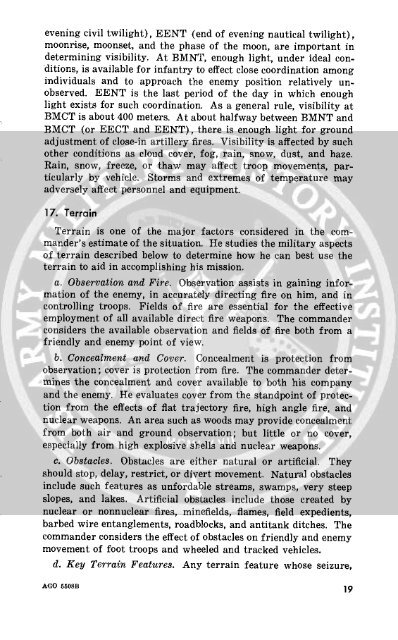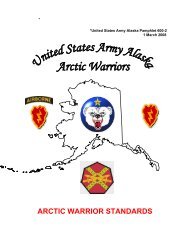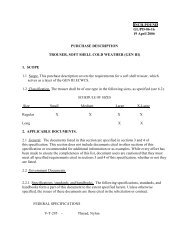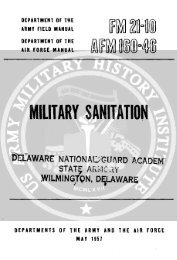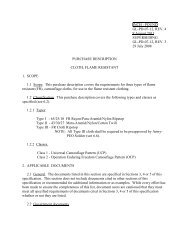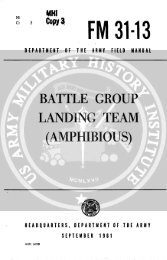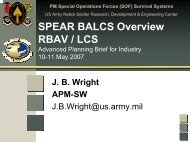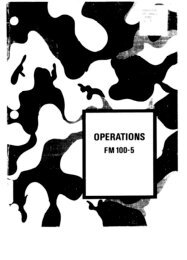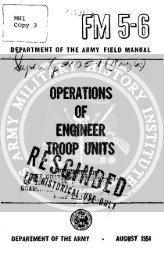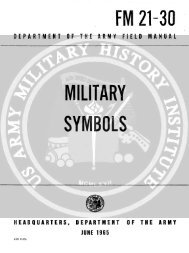- Page 1 and 2: FM 7-10 DEPARTMENT OF THE ARMY FIEL
- Page 3 and 4: Paragrapbs Page Section X. Task for
- Page 5 and 6: . The mission of the rifle company
- Page 7 and 8: Eeh EnPN Figure 1. Rifle company, i
- Page 9 and 10: 6. Duties of Company Headquarters P
- Page 11 and 12: from current communication orders (
- Page 13 and 14: 8. Duties of Weapons Platoon Person
- Page 15 and 16: 10. CBR Operations CBR operations a
- Page 17 and 18: friendly and enemy viewpoint to eva
- Page 19: mands the attached unit. Normally,
- Page 23 and 24: trained to report all information o
- Page 25 and 26: d. Operation orders contain instruc
- Page 27 and 28: WPN5 I 'A ... AAA4 ®ee I ALSO FOR
- Page 29 and 30: A A A :TRYT A X A A ITir FO A WPNS
- Page 31 and 32: attle group directed patrol. In suc
- Page 33 and 34: (c) The company commander submits a
- Page 35 and 36: collection and evacuation section a
- Page 37 and 38: for the number and type of rations
- Page 39 and 40: the antitank squads so that no squa
- Page 41 and 42: from ground and air observation, af
- Page 43 and 44: soldier. Additional maintenance ass
- Page 45 and 46: d. All-Around Defense. The commande
- Page 47 and 48: a. Function as part of the general
- Page 49 and 50: t /106~~~~~~~~~~ 1 . X /.(4. 3.5 5
- Page 51 and 52: ifle company participates in the mo
- Page 53 and 54: N:MI¥ UP TO 15 M UP TOZ50M UPTO4WM
- Page 55 and 56: He may shift forward platoons to th
- Page 57 and 58: of their impact area is as close as
- Page 59 and 60: f. Flame. Portable or mechanized fl
- Page 61 and 62: company, or they may be attached to
- Page 63 and 64: company. Authority to fire Davy Cro
- Page 65 and 66: not otherwise under surveillance. T
- Page 67 and 68: UP TO 400 METERS PHYSICALLY OCCUPIE
- Page 69 and 70: is not assigned, one squad may be p
- Page 71 and 72:
available to assist the platoon lea
- Page 73 and 74:
(2) At night and during other perio
- Page 75 and 76:
post to pass through units in prepa
- Page 77 and 78:
ased on instructions from the plato
- Page 79 and 80:
It should give the best possible vi
- Page 81 and 82:
g. If it appears that a penetration
- Page 83 and 84:
tions, makes a quick, decisive assa
- Page 85 and 86:
. If the enemy succeeds in penetrat
- Page 87 and 88:
ENEMY t TI -I Figure 15. Rifle comp
- Page 89 and 90:
on the far side. When the FEBA is f
- Page 91 and 92:
Section VIII. RESERVE RIFLE COMPANY
- Page 93 and 94:
. The company or its elements may b
- Page 95 and 96:
h. Relief Order. The relief order,
- Page 97 and 98:
CHAPTER 4 OFFENSE 87. Mission Secti
- Page 99 and 100:
against the principal objective (s)
- Page 101 and 102:
107). During his reconnaissance, th
- Page 103 and 104:
the company and jeopardize chances
- Page 105 and 106:
pany. When this occurs, the company
- Page 107 and 108:
those terrain features to which rap
- Page 109 and 110:
ment of the mission. While there ar
- Page 111 and 112:
103. Security a. Security is the re
- Page 113 and 114:
and the possibility of masking supp
- Page 115 and 116:
can best control the entire platoon
- Page 117 and 118:
support available to him. Decisions
- Page 119 and 120:
assault. They provide maximum fire
- Page 121 and 122:
attack position at the appropriate
- Page 123 and 124:
; -- ... . 9 - --- d i _ , '_ I x I
- Page 125 and 126:
d. When deployment is completed, th
- Page 127 and 128:
(1) The company commander locates h
- Page 129 and 130:
128 (3) Selection of firing positio
- Page 131 and 132:
(b) The mortar section usually move
- Page 133 and 134:
objective, the situation, strength,
- Page 135 and 136:
Figure 20. Dismounted infantry and
- Page 137 and 138:
Figure 22. Mounted infantry and tan
- Page 139 and 140:
(3) Casualties will be minimized in
- Page 141 and 142:
ganized positions. The company atta
- Page 143 and 144:
(4) The company commander normally
- Page 145 and 146:
exposed flank or near the area of a
- Page 147 and 148:
(1) Tanks and infantry become undul
- Page 149 and 150:
loss of APC if the unit becomes inv
- Page 151 and 152:
(5) The reduction of enemy resistan
- Page 153 and 154:
employed depends on such factors as
- Page 155 and 156:
g. Zones of Action and Objectives.
- Page 157 and 158:
(2) If visibility permits control o
- Page 159 and 160:
. During an attack by stealth, illu
- Page 161 and 162:
To facilitate the positioning of su
- Page 163 and 164:
his supporting fires to determine i
- Page 165 and 166:
carriers or helicopters to seize re
- Page 167 and 168:
to dismount through the top hatches
- Page 169 and 170:
ENEMY I NOT TO SCALE Figure 29. Org
- Page 171 and 172:
guide is required for each platoon.
- Page 173 and 174:
control, it is made up of only thos
- Page 175 and 176:
achieving surprise and maintaining
- Page 177 and 178:
which must be thoroughly coordinate
- Page 179 and 180:
destroy small guerrilla bands and t
- Page 181 and 182:
CHAPTER 5 RETROGRADE OPERATIONS Sec
- Page 183 and 184:
h. Detailed plans are made in advan
- Page 185 and 186:
. When a unit is ordered to act as
- Page 187 and 188:
platoon leader to command a reconna
- Page 189 and 190:
of the detachments left in contact,
- Page 191 and 192:
177. General Section III. DAYLIGHT
- Page 193 and 194:
able APC to the forward platoons in
- Page 195 and 196:
181. General Section IV. DELAYING A
- Page 197 and 198:
elements of the platoon to withdraw
- Page 199 and 200:
CHAPTER 6 AIRBORNE OPERATIONS 186.
- Page 201 and 202:
(1) Assault echelon. This echelon i
- Page 203 and 204:
Loading forms are completed to the
- Page 205 and 206:
Section III. JOINT AIRBORNE OPERATI
- Page 207 and 208:
and line of departure are seldom us
- Page 209 and 210:
(1) Is free from enemy troops and s
- Page 211 and 212:
c. Preparation of Equipment for Aer
- Page 213 and 214:
pany mission. Individual stragglers
- Page 215 and 216:
ability of the company to plan, coo
- Page 217 and 218:
can provide surveillance coverage t
- Page 219 and 220:
LD LD hi Figure 37. Scheme of maneu
- Page 221 and 222:
. Although less desirable, on occas
- Page 223 and 224:
preparations applicable to airmobil
- Page 225 and 226:
223. The Defense a. Airmobile opera
- Page 227 and 228:
withdrawal is based on the battle g
- Page 229 and 230:
position to the rear from which the
- Page 231 and 232:
CHAPTER 7 TACTICAL MOVEMENTS 230. G
- Page 233 and 234:
to protect it from surprise attack
- Page 235 and 236:
. Advance Party. The advance party
- Page 237 and 238:
prescribed by the battle group comm
- Page 239 and 240:
force is not expected to engage in
- Page 241 and 242:
with adequate direct and indirect f
- Page 243 and 244:
APPENDIX I REFERENCES AR 59-106 AR
- Page 245 and 246:
FM 24-18 FM 24-20 FM 25-10 FM 27-10
- Page 247 and 248:
(c) He then develops courses of act
- Page 249 and 250:
APPENDIX III OPERATION ORDERS Secti
- Page 251 and 252:
The 2d BG, 15th Inf, on our right a
- Page 253 and 254:
APPENDIX IV COMBAT FORMATIONS Secti
- Page 255 and 256:
(4) When the rifle squad moves as p
- Page 257 and 258:
ENEMYt TEAM BURAVo Figure 43. Examp
- Page 259 and 260:
ENEMY t / TEKAM SIGNAL ISUPPLEMENTE
- Page 261 and 262:
ENEMYI N t 1 R I )1 ,- " ISLJ I I,
- Page 263 and 264:
ENEMY t NOVE I ARB 'as EAST I or I
- Page 265 and 266:
Figure 49. Movement by successive b
- Page 267 and 268:
ENEMY t I -- tSM--- _U wPN SQUAD 0
- Page 269 and 270:
R SQUAD U L tM ± ECHEOLON RIGHT (L
- Page 271 and 272:
ENEMY t 0 |'\ A,' I / a A S 9 I I I
- Page 273 and 274:
t ENEMY 0 Ii 19 0 Lj a (4) Echelon
- Page 275 and 276:
22 :I LEGEND U a. Loading. Normally
- Page 277 and 278:
200 M \ / \ / 2 WPNS 3 150-300 M Fi
- Page 279 and 280:
they are to take immediately after
- Page 281 and 282:
c. Battlefield Signals. (1) Signals
- Page 283 and 284:
members practice in applying the pr
- Page 285 and 286:
ASSAULT U~ 2~. -- \-__ PHASE MOVE 3
- Page 287 and 288:
the fire support role to cover the
- Page 289 and 290:
SIGNAL - FIST CLENCHED AND THRUST I
- Page 291 and 292:
i11 SIGNAL Figure 69. Maneuver fron
- Page 293 and 294:
.k - / MANEUVER '/" " \ ' ELEMENT d
- Page 295 and 296:
INITIAL FIRE / 1/:/ INITlAL SUPPORT
- Page 297 and 298:
situation-must be decided by the sq
- Page 299 and 300:
I I-I 0 I I / I / \I_ A\ 0 3 \_)j (
- Page 301 and 302:
S 0 ----- 00-_____ I I I I l\, \ I
- Page 303 and 304:
--- Q0 I I1 II '_} /I L' o>'[ / I \
- Page 305 and 306:
\ /o I I I / I. \\ 10 'wl I ,I \ -
- Page 307 and 308:
l Xri~~~~~~~~~ II o / iWl / (3) Man
- Page 309 and 310:
and 9.6 KMPH for the M59), particul
- Page 311 and 312:
Figure 79. Table for converting met
- Page 313 and 314:
Figure 81. Downstream drift in a st
- Page 315 and 316:
. All turns in the water are made t
- Page 317 and 318:
Paragraphs Page Command and adminis
- Page 319 and 320:
Fire support . ….................
- Page 321 and 322:
Paragraphs Page Night withdrawal: C
- Page 323 and 324:
Paragraphs River crossing: Conduct
- Page 325:
BY ORDER OF THE SECRETARY OF THE AR


